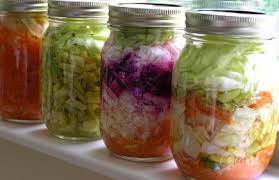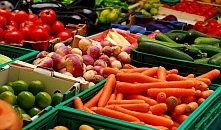Let’s get acquainted with fermentation!
 Before we explore the fascinating subject of fermented foods, let’s get familiar with a few of the most commonly used words.
Before we explore the fascinating subject of fermented foods, let’s get familiar with a few of the most commonly used words.
What is lacto-fermentation?
The word lacto comes from the name lactobacilli, which biologists have given to a broad family of friendly bacteria. Some of these bacteria are specific to milk, such as in yogurt and cheeses; others are specific to vegetables.
They have one characteristic in common: they transform sugars into a beneficial form of lactic acid.
Lactic acid
The term lactic acid is used in several contexts. One form of lactic acid is produced in the body itself as a result of exercise, where its buildup can sometimes cause cramping pains. Another form is a synthetic lactic acid, which is used as a preservative and flavoring in foods, beverages and pharmaceuticals.
The lactic acid produced by fermentation is neither of these. During the fermentation process the friendly lactobacilli bacteria break down the sugars in fruit and vegetables to produce a special form of lactic acid that acts as a natural preservative.
What’s in a name? In case you were wondering . . .
In connection with lacto-fermentation, the terms fermented and cultured are interchangeable.
The history of fermented foods
Throughout history, lacto-fermentation has been used to preserve foods. We know that fermented cabbage was a staple food for the workers building the Great Wall of China. Captain Cook’s sailors were fed fermented cabbage on their voyages, since it was well known at that time as an effective way to prevent scurvy.
Sauerkraut is the national staple food of Germany with some interesting folklore. A spicy fermented dish called Kimchi is so integral to the Korean culture, they have a museum dedicated to Kimchi. Many diverse vegetables, fruits, seeds, and grains have been fermented in cultures throughout the world.
With the development of pasteurization and industrialized canning and freezing as methods of food preservation, the traditional technique of making fermented foods is no longer used in many developed countries.
 Nutritional benefits
Nutritional benefits
We all know that vegetables are good for our health. Fresh raw produce is abundant during the harvesting season, and is full of vitamins, minerals and phytonutrients.
Fermenting vegetables not only increases the nutrients, but also provides live enzymes and beneficial friendly bacteria.The health benefits of these probiotic bacteria are far-reaching:
- They help the digestion process by regulating the level of acidity through stimulating the production of beneficial intestinal flora.
- They generate antioxidant molecules.
- They have a soothing effect on the nervous system
- They provide a natural barrier and protect our bodies from invaders such as parasites, fungi, viruses, toxins and harmful bacteria.
Challenges
Although the process of lacto-fermentation has been used safely for thousands of years, there are some challenges. Various factors can affect not only the quality (taste and texture), but also the consistency and safety of the final product:
- Freshness and quality of the vegetables
- Fermentation time
- Temperature
- Salt quality, content and quantity
- Secondary fermentation (after the product is packaged) causing swelling and ‘fizziness’.
However, when the fermenting process is controlled correctly, the raw cultured veggies are stable and safe, and can be kept in cold storage for a long time.
Preserving Tradition with Science
Nature and science can sometimes combine to provide a good solution. Researchers at the Food Research and Development Centre (FRDC) of Agriculture and Agri-Food Canada have studied the complex workings of traditional fermentation.
The research found that an important requirement is to use a mixed-strain starter culture that contains the appropriate bacterial strains for vegetable fermentation – and in the correct proportions.
Culturing your own vegetables
 Whether you use veggies from your garden or buy fresh organic vegetables in season, preserving them with lacto-fermentation provides your family with nourishing, delicious and safe food well beyond the harvest season.
Whether you use veggies from your garden or buy fresh organic vegetables in season, preserving them with lacto-fermentation provides your family with nourishing, delicious and safe food well beyond the harvest season.
When you make sauerkraut or a combination of cultured vegetables, why take chances on the results?
Starter cultures used for dairy foods are not suitable for vegetables. For consistently successful results, use Caldwell’s Starter Culture, which contains the correct strains of bacteria specific to fermenting vegetables, in the right proportions.
And if you don’t have time to ferment your own veggies, or the patience to wait till they’re ready, just choose from our range of Caldwell's delicious ready-to-eat fermented vegetables.
For more in-depth information, download this paper by Simon Gorman published in the May 2011 Food Chain Journal about fermented foods and their potential for providing food security.
Disclaimer: These statements have not been evaluated by the Food and Drug Administration. These products are not intended to diagnose, treat, cure, or prevent any disease.
Information provided in this article is not designed to and does not provide medical advice, professional diagnosis, opinion, treatment, or services to you or to any other individual. This is general information for educational purposes only. The information provided is not a substitute for medical or professional care, and you should not use the information in place of a visit, call, consultation, or the advice of your physician or other healthcare provider. Wise Choice Marketing Inc is not liable or responsible for any advice, course of treatment, diagnosis, or any other information, services, or product you obtain through Wise Choice Marketing Inc.


 Loading... Please wait...
Loading... Please wait...













